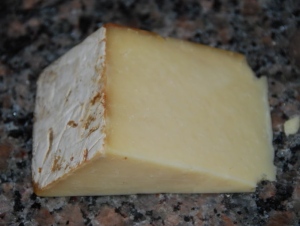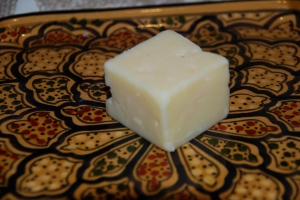Browning Gold: A Sweet Cheddar Cheese
February 24, 2011
Browning Gold is a humble cheese. At the cheese counter, it does little to differentiate itself from other aged cheddars. Yet what it lacks in visual intrigue, it makes up for in flavor. Browning Gold offers warmth and sweetness, and seems a natural fit for a casual intimate gathering. More importantly, Browning Gold retired my family’s bias against aged cheeses.
Browning Gold is a hard, cheddar-style cheese produced by 5 Spoke Creamery in Westchester County, New York. It is farmstead produced with raw cow’s milk and cave-aged for 24 months before market. The cheese is produced in a large brick format; each cheese weighs about 10 pounds.
 Browning Gold looks as if it has been wrapped in a white paper skin. The rind’s surface molds give the exterior a velvety feel. The interior paste is the color of pale straw, darkening to nutmeg at the rind. To the touch, the paste is solid and a bit greasy.
Browning Gold looks as if it has been wrapped in a white paper skin. The rind’s surface molds give the exterior a velvety feel. The interior paste is the color of pale straw, darkening to nutmeg at the rind. To the touch, the paste is solid and a bit greasy.
Browning Gold has a musty aroma. Its rind smells like fresh earth and mushrooms. Its interior paste has a baked cheese cracker scent.
Browning Gold has deep flavor and marked sweetness. Its flavors are strongest at the start, then mellow while chewing. Its dominant flavors are a warm nuttiness and pineapple sweetness. The cheese also has a some sourness. It leaves a mild aftertaste.
The cheese has a moist and crumbly texture in the mouth. Browning Gold breaks into pebble-sized morsels on the tongue, encouraging one to savor the cheese.
With its sweeter profile, Browning Gold was an easy sell at our table. One juvenile taster commented that it tasted like a sweet and savory sauce. We all liked this cheese a lot. The day after our tasting, there was a hasty scramble for the remaining cheese.
Browning Gold is a superb stand-alone cheese. Its crumbly texture demands slow eating and seems ideal for a casual gathering. It would be fantastic on a day hike, camping or as an everyday cheese.
Purchase Notes: I purchased Browning Gold at Cowgirl Creamery (San Francisco). The cheesemonger commented that Browning Gold is available occasionally.
Montgomery’s Cheddar: The Cheddar Master
January 21, 2011
Montgomery’s Cheddar is a country beauty with great flavor, inviting aroma and a chewy texture. While cheddar cheese may not seem all that exciting at the cheese shop, Montgomery’s is a benchmark cheddar and should not be missed. My 11-year-old said it best about Montgomery’s: “This is what cheddar cheese should taste like.”
Montgomery’s Cheddar is farmstead produced by Manor Farm in Somerset, England. It is considered a classic example of English farmhouse cheddar, made from raw cow’s milk. Manor Farm hews to tradition when making Montgomery’s and uses a “peg mill” to cut the cheese curds. This technique affects the cheese’s texture and creates its characteristic fissures. Cheeses are aged 12-14 months before release and may age further with affineur, Neal’s Yard Dairy.
 Montgomery’s is a quiet beauty. Its rind is embossed with the tight weave of its traditional cloth wrap. The rind looks like paint-brushed canvas with a palette of soft burgundy, caramel, gold, deep green, gray, and beige. The interior paste is a rich yellow, darkening to butterscotch near the rind. The paste is fissured, dry and smooth.
Montgomery’s is a quiet beauty. Its rind is embossed with the tight weave of its traditional cloth wrap. The rind looks like paint-brushed canvas with a palette of soft burgundy, caramel, gold, deep green, gray, and beige. The interior paste is a rich yellow, darkening to butterscotch near the rind. The paste is fissured, dry and smooth.
Montgomery’s has an inviting aroma. The interior paste smells like a meadow of rich soil, flowers, grass and herbs. Its rind smells like roasted peanuts.
Montgomery’s Cheddar has complex flavor: it is sour, tangy, fruity and nutty. There is a compelling fruitiness to this cheese that gives it balance and a full flavor. The cheese ends tangy, but its tanginess is not overwhelming or dominant. Even the after-taste of Montgomery’s has complexity, leaving sour fruit and nutty flavors on the tongue.
The cheese has a chewy texture that encourages slow eating. The cheese is prone to breaking along its fissures when slicing with a knife.
Montgomery’s is packed with flavor, yet my kids described it as a “mild” cheddar. Its flavors are very well-balanced and compelling. Montgomery’s makes a happy snacking cheese, could hold its own at a party, or be toted along for an outdoor meal. Montgomery’s Cheddar is a definite re-purchase.
Purchase Notes: We purchased Montgomery’s Cheddar at Cowgirl Creamery (San Francisco).
Beecher’s Flagship Reserve: Addictive American Cheddar Cheese
January 15, 2011
Beecher’s Flagship Reserve is a lovely American cheddar cheese. I took this cheese home on a theory that with cooler winter weather, my family would appreciate a more complex cheese. I hoped that our panel’s aged-cheese-rejectors would give Flagship Reserve a fair shake. I expected the worst from my tasters. Yet Flagship Reserve won over the whole crew.
Flagship Reserve is a firm cheddar-style cheese from Beecher’s Handmade Cheese in Seattle, Washington. Flagship Reserve is a special version of Beecher’s Flagship cheese, made “only on days when the milk composition is just right.” The cheese is produced with pasteurized cow’s milk, then bound in cloth to mature. It is open-air aged for 13-16 months before market.
Beecher’s Flagship Reserve is statuesque and solid. Our sample (about 5″ tall) is just half the height of the whole cheese. The cheese has a natural rind that shows the tight weave from its cloth wrap. The interior paste is yellow-beige, with its color intensifying towards the rind. The cheese paste is smooth to the touch.
The rind smells fresh and natural like the outdoors: it has a faint cedar-like scent. Flagship Reserve’s aroma has an inviting aroma that is cheesy and fruity.
Flagship Reserve’s flavor is intense from the get-go. It is initially very nutty and tangy, just short of cheek-puckering. It has an underlying sour fruitiness that gives the cheese balance and mellows its tanginess. Flagship Reserve ends tangy and sour, with these flavors lasting long in the mouth after eating. The cheese has a nice, chewy texture.
Flagship Reserve is an addictive cheese. Its flavors are intense, yet offer a lot of complexity. The flavors linger nicely on the tongue and encourage further eating. We all liked this cheese a lot.
Flagship Reserve is a versatile cheese. It is easy to eat on its own as a snack, but has enough weight and complexity to make it a good one to share at a party. I’d take this camping, on a picnic or a hike. I expect it would be superb in recipes that call for cheddar cheese.
Purchase Notes: We purchased Beecher’s Flagship Reserve at Cowgirl Creamery. It is also available in 1-lb quantities at Beecher’s Handmade Cheese.
Beaufort: A Bomb from the French Alps
July 17, 2010
Beaufort is a raw cow’s milk cheese from the Haute Jura area in France, close to the Swiss border. Cows grazing on alpine grasses provide the milk used in its production. Beaufort is aged for 18 months, has a natural edible rind and arrives in huge 80-pound wheels.
Our sample of Beaufort was a thin slice from a large, doorstop-sized chunk. The interior of the cheese is a deep, golden yellow. This cheese is smooth and solid. Its surface unmarred by holes or fissures. At the rind, the cheese has orange and brown tints. The rind itself is a warm tan. (Note: To see what Beaufort looks like in the shop, try this photo).
Beaufort’s aroma is not strong, but it smells like a farm. The interior has the scent of butter and the rind smells like cow and dried hay.
Unlike other hard cheeses we’ve tried, this one bends. Our thin slices of Beaufort broke up into large chunks as we handled the cheese during the evaluation. Beaufort’s surface is greasy to the touch.
Beaufort’s flavors start softly, but end sharply. It is very mild at first, almost like a light Gruyere. It finishes with a nutty, salty flavor that is stronger but still milder than an Aged Gouda. The bang from this cheese comes at the very end: the cheese really coats the mouth with its flavors and after swallowing, a felt-like feeling remains.
Beaufort did not win any fans during our evaluation. Half of the tasters were unimpressed by its mild flavor (a guest taster called it boring) and the others were put off by its after-effects. Ben called the after-effect “spicy,” but this is his catchall description for foods that produce negative mouth effects. No one wanted to purchase this cheese again.
When we purchased this cheese, our cheesemonger raved about Beaufort calling it “the bomb.” Yet this cheese literally bombed with all tasters. Conclusion: preference is informed by personal likes and experience and best not be too swayed by other’s raves.
Fiscalini Bandage Cheddar: A Cheese of Substance
July 2, 2010
Bandage Cheddar is a raw cow’s milk cheese, made by Fiscalini Farms in San Joaquin County, California. This cheese is “bandaged” in cheesecloth during its aging period of 16-36 months.
Bandage Cheddar is pale blonde in color. It has small holes throughout, creating ridges in its surface texture. This cheese has a dense, solid feel. (Note: We received an unusual sample with just the cheese’s interior and no rind. Our photo does not reflect the cheese’s shelf appearance).
The scent of Bandage Cheddar is much like other aged cheddars–tangy and very sharp when held close to the nose. Bandage Cheddar’s scent gives true hint of its expected flavors.
Bandage Cheddar has a sharp flavor, much like other good aged cheddars. Its flavor begins tangy and sharp and leaves an even tangier aftertaste. Jacob thought its tanginess was close to Aged Gouda, yet noted that it was a lot sharper. The sharpness was not biting or acidic and lingers briefly on the tongue. A thin slice of Bandage Cheddar yields many enjoyable flavors.
We all liked this cheese, yet it did not make our repurchase list. Ben suggested that this cheese would do better with a more substantial bed than french baguette. He’s right! The airy baguette was too wimpy for Bandage Cheddar. This cheese deserves a hearty pain au levain-style bread to support its complex flavors. Bandage Cheddar would make a good fall cheese with pears or apples, and I bet it would be delicious melted on anything.
Gouda, Aged 2 Years: Just a Lot of Tang
June 19, 2010
Gouda can be a young semi-soft cheese or an aged hard cheese. We tried a dutch Gouda that had been aged for 2 years. This cheese is made from cow’s milk. Our sample of Aged Gouda is the color of uncooked pasta, deepening in color towards the rind. Ben noticed that it’s hard surface was slippery like glass yet uneven with some dimples and bulges. Jacob said the cheese had an aroma similar to parmesan cheese. The cheese is hard and dense with a thick rind. Use a sharp knife with this cheese as it is hard to cut. Slices flake from the cheese. A small flake packs a lot of flavor. Jacob and Ben agreed that this cheese is tangy–very tangy. Ben commented that it had an even tangier after taste (we need to develop a tang-o-meter to scale cheeses on this adjective). Neither was willing to buy it again. I’m partial to hard aged cheeses and I liked it. Matt was ambivalent. The 2-year Aged Gouda may not warrant a second try for us, but it would make a fitting end to a rustic meal.


